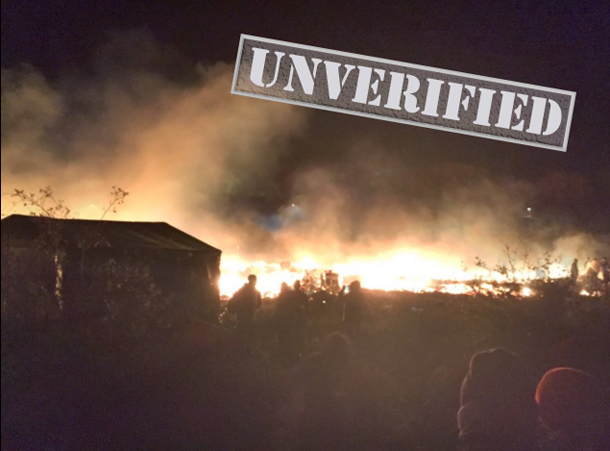When columnists say social media is changing journalism -- for better or worse, but usually worse -- it doesn't tend to sink in until the world is facing a major crisis in real time.
This weird new normal hit home Friday afternoon.
Like millions of others I sifted through Twitter hashtags and Facebook posts for updates following the terror attacks in Paris, never quite trusting anything that came across my feed. I'd learned to stay hyper-skeptical years ago when #Ferguson rumours and #HurricaneSandy photo mash-ups led so many friends and reputable news organizations astray.
To paraphrase author Alfred Hermida (who declared this "messy" new reality following last year's Parliament Hill shooting here in The Tyee): the bigger the news, the louder the noise.
And noisy it was. One Photoshop hoax grafted fake explosives onto a Sikh-Canadian man's bathroom selfie, and turned the iPad he used to snap the photo into a Koran. Spanish newspapers published the offending photo, provoking Veerender Jubbal to fear for his own safety. No one seemed to ask: how does one take a selfie with a Koran?
But in the chaos of several thousand tweets a minute, I also saw many journalists using the language and etiquette of responsible verification: weeding out inaccuracies, questioning the authenticity of photos and shaming organizations for broadcasting "unconfirmed" reports. Reporters are no longer just concerned with getting the story right; they're also learning to actively debunk hoaxes and stop the spread of misinformation.
Tom Trewinnard tells me these social media verification muscles have been years in the making -- tested in crisis after crisis. Trewinnard is research and communications manager for Meedan, a company that works to translate and verify digital eyewitness media.
"We probably started working on this four and a half years ago," recalls Trewinnard, who has also contributed to a handbook on social media verification. "It still feels like an emerging field."
Though the tech side has made strides over the years -- new apps can detect Photoshop use or interpret a file's metadata -- it's the human side that's done the most adapting. "Often there aren't really structures in place for social media newsgathering, but that's starting to change," Trewinnard says.
A growing catalogue of too-common mistakes in verification has pushed newsrooms to adopt best practices. A coalition of publishers, journalists and technology companies called First Draft, which launched in April, is documenting high-stakes case studies.
Spotting photo fictions
Some of the more harmless but widespread hoaxes following the Paris attacks weren't Photoshopped, but clips of monuments taken out of context. Tweets claimed the Eiffel tower went dark to honour the dead. In fact, the lights go out every night at 1 a.m., and the widely-shared video was from January 2015.
Other photos of landmarks lit up in blue, white and red were passed off as real-time captures, when in reality many of them were taken following the Charlie Hebdo attacks earlier this year.
"The first step, which should be done for any image, is a reverse image search," advises Trewinnard. "It takes about four clicks and 30 seconds to see if the image has existed online."
Using Google's image search function, or a web tool called TinEye, reporters can find whether a photo has been uploaded days, weeks or months before -- an instant red flag for posts claiming to reflect real-time scenes from an emergency.
Such mix-ups are not necessarily malicious, Trewinnard adds. When photos are stripped of their context, it's too easy for users to mistake them for on-the-ground dispatches, he says. "It's a really common problem."
New media organizations like Buzzfeed and Quartz were quick to debunk photo rumours, including one of a vigil for Charlie Hebdo victims.
But reverse image search is just step one of many in the world of hoax hunting. "If it hasn't appeared online before, it doesn't mean it's perfectly valid," warns Trewinnard.
Depending on a newsroom's resources and commitment to verification, reporters can work to confirm location, original uploader, and test whether any visual indicators suggest a composite. Google Street View, Twitter's advanced search function and even weather reports can kickstart these efforts.
"You're looking for any inconsistencies that might point to the fact it's not showing what it claims to show."
Verification as process
Inevitably, though, these verifications efforts are fast-paced and messy, as Egyptian journalist and Meedan team member Sarah Othman found out when verifying reports of a fire at Calais refugee camp in France following the attacks.
Several versions of the story were debunked over the course of the evening. Russia's broadcaster RT erroneously reported the camp was "set on fire," possibly by vengeful French citizens. One video was reportedly from a previous fire at the camp. This led many online observers to overcorrect, and claim the fire itself was a hoax.
In her verification attempts, Othman says she used Twitter's location search to find tweets from the inside camp, and asked those users to make sure the news was coming from inside. "They denied that the French people were setting fire to the refugee camp," says Othman. "The fire was an accident."
These are situations where First Draft's collaborative hoax tracking work comes in handy. Examining case-by-case, best practices for verification start to emerge.
One of those best practices is to limit the sharing of unsubstantiated information, even when in search of corroboration. (Better to do these confirmations offline, or by email, than risk fanning flames of a potential hoax).
That was a lesson learned during the Boston marathon bombings, where retweets seeking new information bred panic and inaccuracy. "During the Boston marathon bombing a lot of rumour spread very quickly, which created a strange echo-chamber effect," Trewinnard says.
At the time, unverified claims about the number of victims and the location of the blasts were picked up from the web and talked about on police scanners. Those police scanner reports bled back into social media, and onto the pages of traditional media.
First Draft's crisis debriefing of the Boston bombing shows all players are still learning, despite high stakes and plenty of emerging technology. Trewinnard notes the skill of verification takes plenty of practice, but doesn't require much more than a grasp of journalism's basic tenets.
"Right now we talk about verification like it's a separate field, but really -- and I suspect that separation will disappear -- we still want to know the who, what, when, why and how." ![]()
Read more: Media, Science + Tech
















Tyee Commenting Guidelines
Comments that violate guidelines risk being deleted, and violations may result in a temporary or permanent user ban. Maintain the spirit of good conversation to stay in the discussion.
*Please note The Tyee is not a forum for spreading misinformation about COVID-19, denying its existence or minimizing its risk to public health.
Do:
Do not: